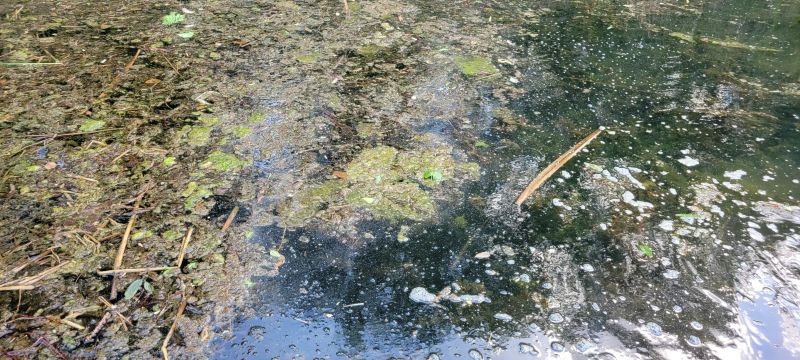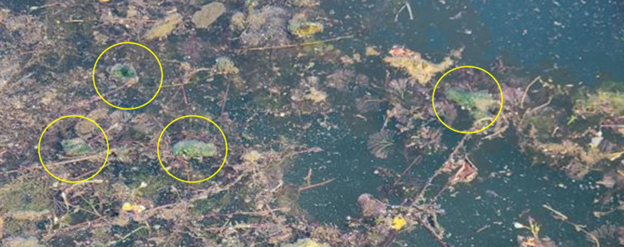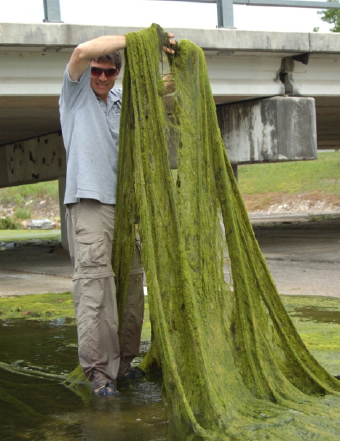Austin’s waterways are home to many different types of algae that play important roles in the natural world. Algae provide oxygen, food, and habitat for aquatic life. They also convert carbon dioxide and other raw nutrients into usable parts of the ecosystem. However, if there’s excessive algae, it can hurt rather than help the environment. Algae may smother habitat or foul the water with decay. On top of that, some species of blue-green algae can produce toxic byproducts.
In Austin, the deaths of six dogs have been attributed to toxins since 2019. It is believed they swallowed blue-green algae.
Current Status
September 30, 2025: We're seeing much less algae on the lakes. But, there's still some out there, so continue to be cautious and treat all algae like it may be toxic.
When playing along Austin’s waterways, please be cautious:
- There is always some level of risk.
- Look for indications that you should not enter the water. See the “Staying Safe” section.
- Contact your medical provider or veterinarian for sudden, unexplained illness after swimming.

Algae at Red Bud Isle, April 16, 2025
- Staying Safe
-
There is always some level of risk from the presence of algae, bacteria, parasites, and other dangers in any natural water body. Although we keep an eye on the condition of our lakes and creeks, there is no amount of testing that could be done to assure them safe from all risk.
People and Pets
Caution: Enter Water at Your Own Risk
- Do not drink water directly from natural water bodies.
- Avoid contact with algae.
- Rinse skin or animal fur after contact with water.
- Do not allow dogs to lick their fur prior to rinsing.
Do Not Enter Water If:
- Water is warm or stagnant or you see scum, film, or algae.
- There has been rain in the past three days.
Note that people are not allowed to swim in Lady Bird Lake (Ord. 640611-C).
- If You or a Pet Get Sick
-
If you or a family member have sudden, unexplained symptoms after swimming, contact a healthcare provider or the Poison Control hotline at 1-800-222-1222.
If your pets or livestock seem sick after going in or near water, contact a veterinarian right away. You can also call the ASPCA Animal Poison Control Center at 1-888-426-4435 or the Pet Poison Helpline at 1-855-764-7661. Note that there is a fee for these calls.
Please also consider notifying Austin Public Health by filling out this reporting form:
- Harmful Algal Suspected Illness Reporting Form
- Formulario de Reporte por Sospecha de Enfermedad por Proliferación de Algas Dañinas
Potential Toxins
Since 2019, we have detected the following toxins in algae mat samples. Fortunately, the toxins have only rarely been found in water samples. When found in water samples, the toxins have been present at very low levels well below any safety thresholds.
- Anatoxin-A and its variants, dihydroanatoxin-a or homoanatoxin-a
- Cylindrospermopsin
- Microcystin
Resources for physicians
- CDC Cyanobacterial Blooms: Information for Healthcare Providers
- Association of State and Territorial Health Officials Cyanobacterial Blooms and Associated Illnesses A Clinician Toolbox for Physicians and Healthcare Providers: Cyanobacterial Blooms and Associated Illnesses
Resources for veterinarians
Resources for the public
- Blue-green Algae
-
Cyanobacteria (also known as blue-green algae) are one of the earliest forms of life and are found throughout the world. There are many different species. Despite their misleading common name, they are not technically algae. Rather, they are a type of bacteria, which is why they are more properly called cyanobacteria.
Blue-green algae are typically microscopic but can be easily seen when they form colonies or are spread throughout the water. They usually look like dark green or dark blueish-green slimy blobs. They are often mixed in with other types of algae (see photo).

When blue-green algae grow in large numbers, they may produce enough toxins to harm animal life (including humans). When the toxins are confined within the mats without releasing toxins into the water, the situation is known as a “harmful algae proliferation”. Since 2019, we have become aware of harmful algae proliferations on Lady Bird Lake including locations such as Red Bud Isle and the backwater area between the lake and Barton Springs pool. There have also been proliferations in Lake Austin and Lake Travis. They may happen in other water bodies like ponds and creeks as well.
In more serious cases, single algae cells can be spread out and dispersed densely throughout the water. This second scenario is called a “harmful algae bloom.”
Although harmful algae blooms can be seen in lakes around the world, we have not seen it happen in our lakes. However, they are known to occur in ponds and even in small pools of water in creeks when flow has stopped. We have even seen a harmful algae bloom in Barton Creek below Sculpture Falls. This has happened in the summer when the water was drying the creek into an isolated pool of water. Stock ponds and stormwater ponds have the highest risk for a harmful algae bloom. Although these ponds may be attractive, their water quality tends to be poor and may not suitable for recreation for either people or pets.
Keep in mind:
- There are many types of blue-green algae. Some of them can produce toxins, but that doesn’t mean they always do so.
- There are several different types of toxins.
- The conditions that are most likely to produce algal blooms or proliferations include warmth, low flow, and high levels of nutrients.
- Green Algae
-
Green algae species can be slimy or rough, but they do not produce cyanotoxins. One of the more common species of green algae is Cladophora. It can be bright green or dull green and usually feels wooly or rough like dirty hair.

Cladophora can be a nuisance, forming thick mats that can fill the water of a creek, especially in the late winter or early spring. It loves flowing water with lots of nutrients and lots of sunlight. When these three things come together, it can be overwhelming. During the daytime, the Cladophora will produce a large amount of oxygen. However, when night falls, or when algae die, the level of oxygen in the water may drop resulting in fish kills.
Although Cladophora does not produce toxins, it’s possible that toxic blue-green algae might be mixed in with it. The presence of a large amount of Cladophora can be an indication of poor water quality with high nutrient levels. High nutrients in creeks can come from fertilizers that have washed off lawns. People can help reduce algae by limiting their use of fertilizer. Treat all algae like it may be toxic and do not enter water when algae is present.
- Testing and Monitoring
-
Austin Water regularly tests drinking water sources for algae levels near intake pipes on Lake Austin and Lake Travis and has not seen levels of concern for drinking water. Currently, Austin Water does not test Lady Bird Lake because it is not a source for drinking water.
To understand trends with harmful algae proliferations, Austin Watershed Protection has been conducting three special studies in lakes, springs, and in creeks.
Lakes
Austin Watershed Protection is monitoring three sites on Lake Austin and three sites on Lady Bird Lake, visiting them on a regular basis from 2019 to 2026. The frequency has been adjusted every year as the study has progressed. If blue-green algae are observed, then both algae and water samples are collected and sent to a lab. The lab checks if toxins are present and at what concentrations. They also identify which species of algae are in the sample.
Although this is informative and builds our understanding of algae, the samples can only provide a snapshot of conditions at specific locations at specific points in time. The samples are not well suited for determining the safety of an area for recreational use. This is because:
- Sample results may take weeks to return
- Environmental conditions may change rapidly between testing dates
- Conditions may vary throughout the lake.
Negative results in a single sample do not necessarily indicate that an area is free of harmful algae. Over time the monitoring may help us understand how to better predict harmful algae proliferations.
Springs
A partnership with the U.S. Geological Survey studied algae at springs from 2023 to 2024. For this study, we sampled algae at Barton Springs Pool, Backdoor Spring on Barton Creek, Bluff Spring on Onion Creek, Harris Spring on a tributary to Onion Creek, Kizer Spring on Williamson Creek, and Cold Spring on Lady Bird Lake. In this study, we sought to understand whether toxic cyanobacteria may be present at sites generally thought to be atypical for the growth of toxic cyanobacteria. This study was developed after we found anatoxin-a in algae samples from Cold Spring.
Creeks
We are conducting this study from 2024 to 2025. It focuses on collecting blue-green algae in creeks to identify the species that are present and if they have the capacity to produce toxins. Not all cyanobacteria have this capacity. Even if they can produce toxins, they do not always do so. This study is the first step in identifying sites with the highest risk of toxin presence.
- Lanthanum-modified Clay
-
Austin Watershed Protection conducted a five-year pilot program from 2021 to 2025 using lanthanum-modified bentonite to temporarily reduce the amount of phosphorus available to blue-green algae in Lady Bird Lake. Reducing localized phosphorus levels may help prevent the growth of harmful algae in some locations.
2025 Application
A contractor applied lanthanum-modified bentonite at three sites. This clay substance is safe for humans, the environment, & wildlife and settles to the bottom of the lake in a few hours.
Dates:
- June 9 and 10, 2025
- July 21, 2025
- August 4, 2025.
Locations:
- Red Bud Isle
- The boat ramp on the north shore of the lake, just west of I-35
- The north shore of the lake between I-35 and the lagoon behind the Festival Beach Boat Ramp
How Lanthanum-Modified Bentonite Works
Lanthanum-modified bentonite consists of a modified clay material that has widely been used in ponds to prevent harmful algae blooms, which are more likely in warm, stagnant water with high nutrient levels. Lanthanum-modified bentonite binds to phosphorus, a key source of nutrients for algae. Once bound into a mineral form, the phosphorus becomes unavailable to the algae. The idea is to rob the algae of one of its primary food sources and reduce its growth.
2025 is the fifth and final year of this program. The preliminary results since 2021 have been mixed. After the fifth year of application, there will be one year of continued observation without additional treatment to help evaluate the effectiveness of the pilot.
Budget
$300,000 per year for five years (2021 – 2025) including material, application, and monitoring of sediments.
Causes of Algae
We are not aware of any human or pet health problems from harmful algae in Austin prior to 2019. However, we know that algae were a naturally occurring part of the landscape long before humans. We can presume that changes to the algae community may have resulted from changes to the lakes, water quality, and/or many other facets in our ever-changing environment. For example, low flows resulted in the elevated presence of phytoplankton in the lakes from 2011 to 2015 during the drought. Also, the arrival of zebra mussels in 2017, flooding during the fall of 2018, and climate change are potential contributing factors to the harmful algae proliferation in 2019.
High levels of nutrients within water bodies support both blue-green and other types of algae. Although some causes of high nutrient levels are outside of our control, we can all help protect water quality in our creeks and lakes by reducing the use of fertilizers and other lawn chemicals and picking up dog waste.

